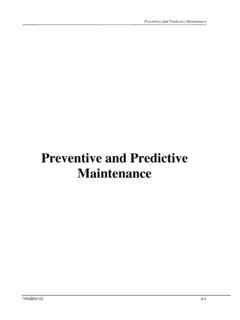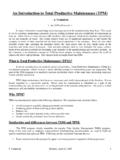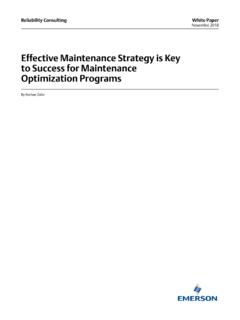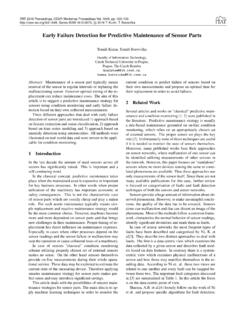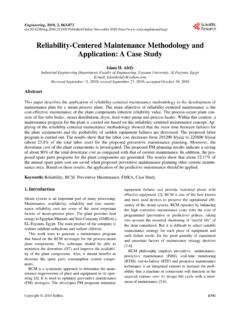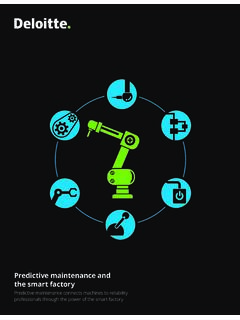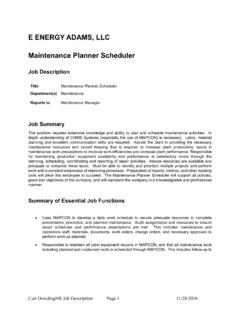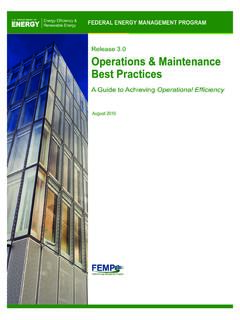Transcription of Maintenance Planning and Scheduling - Mechanical Academy
1 Maintenance Planning and Scheduling Handbook This page intentionally left blank Maintenance Planning and Scheduling Handbook Doc Palmer Second Edition McGraw-Hill New York Chicago San Francisco Lisbon London Madrid Mexico City Milan New Delhi San Juan Seoul Singapore Sydney Toronto Copyright 2006 by Richard D. Palmer. All rights reserved. Manufactured in the United States of America. Except as permitted under the United States Copyright Act of 1976, no part of this publica- tion may be reproduced or distributed in any form or by any means, or stored in a database or retrieval system, without the prior written permission of the publisher.
2 0-07-150155-X. The material in this eBook also appears in the print version of this title: 0-07-145766-6. All trademarks are trademarks of their respective owners. Rather than put a trademark symbol after every occurrence of a trademarked name, we use names in an editorial fashion only, and to the bene- fit of the trademark owner, with no intention of infringement of the trademark. Where such designa- tions appear in this book, they have been printed with initial caps. McGraw-Hill eBooks are available at special quantity discounts to use as premiums and sales promo- tions, or for use incorporate training programs.
3 For more information, please contact George Hoare, Special Sales, at or (212) 904-4069. TERMS OF USE. This is a copyrighted work and The McGraw-Hill Companies, Inc. ( McGraw-Hill ) and its licensors reserve all rights in and to the work. Use of this work is subject to these terms. Except as permitted under the Copyright Act of 1976 and the right to store and retrieve one copy of the work, you may not decompile, disassemble, reverse engineer, reproduce, modify, create derivative works based upon, transmit, distribute, disseminate, sell, publish or sublicense the work or any part of it without McGraw-Hill's prior consent.
4 You may use the work for your own noncommercial and personal use;. any other use of the work is strictly prohibited. Your right to use the work may be terminated if you fail to comply with these terms. THE WORK IS PROVIDED AS IS. McGRAW-HILL AND ITS LICENSORS MAKE NO GUAR- ANTEES OR WARRANTIES AS TO THE ACCURACY, ADEQUACY OR COMPLETENESS OF. OR RESULTS TO BE OBTAINED FROM USING THE WORK, INCLUDING ANY INFORMA- TION THAT CAN BE ACCESSED THROUGH THE WORK VIA HYPERLINK OR. OTHERWISE, AND EXPRESSLY DISCLAIM ANY WARRANTY, EXPRESS OR IMPLIED, INCLUDING BUT NOT LIMITED TO IMPLIED WARRANTIES OF MERCHANTABILITY OR.
5 FITNESS FOR A PARTICULAR PURPOSE. McGraw-Hill and its licensors do not warrant or guarantee that the functions contained in the work will meet your requirements or that its operation will be uninterrupted or error free. Neither McGraw-Hill nor its licensors shall be liable to you or any- one else for any inaccuracy, error or omission, regardless of cause, in the work or for any damages resulting therefrom. McGraw-Hill has no responsibility for the content of any information accessed through the work. Under no circumstances shall McGraw-Hill and/or its licensors be liable for any indirect, incidental, special, punitive, consequential or similar damages that result from the use of or inability to use the work, even if any of them has been advised of the possibility of such damages.
6 This limitation of liability shall apply to any claim or cause whatsoever whether such claim or cause arises in contract, tort or otherwise. DOI: Professional Want to learn more? We hope you enjoy this McGraw-Hill eBook! If you'd like more information about this book, its author, or related books and websites, please click here. To Jesus and Nancy This page intentionally left blank For more information about this title, click here Contents Foreword xix Preface xxi Preface to First Edition xxiii Acknowledgments xxix Prologue: A Day in the Life May 10, 2010 xxxi Chapter 1. The Bene t of Planning 1. Company Vision 1.
7 Why Improvement Is Needed in Maintenance 3. What Planning Mainly Is and What It Is Mainly Not ( , Parts and Tools) 4. How Much Will Planning Help? 9. The practical result of Planning : freed-up technicians 9. World class wrench time 12. The speci c bene t of Planning calculated 13. Why does this opportunity exist? 15. Quality and Productivity Effectiveness and Ef ciency 19. Planning Mission 20. Frustration with Planning 21. Summary 22. Overview of the Chapters and Appendices 22. Chapter 2. Planning Principles 27. The Planning Vision; The Mission 27. Principle 1: Separate Department 29. Illustrations 32. Principle 2: Focus on Future Work 33.
8 Illustrations 39. Principle 3: Component Level Files 40. Illustrations 44. Caution on computerization 46. Principle 4: Estimates Based on Planner Expertise 47. Illustrations 53. Principle 5: Recognize the Skill of the Crafts 55. Illustrations 63. vii viii Contents Principle 6: Measure Performance with Work Sampling 64. Illustrations 69. Summary 70. Chapter 3. Scheduling Principles 73. Why Maintenance Does Not Assign Enough Work 73. Advance Scheduling Is an Allocation 77. Principle 1: Plan for Lowest Required Skill Level 79. Illustrations 82. Principle 2: Schedules and Job Priorities Are Important 84. Illustrations 85.
9 Principle 3: Schedule from Forecast of Highest Skills Available 88. Illustrations 91. Principle 4: Schedule for Every Work Hour Available 93. Illustrations 96. Principle 5: Crew Leader Handles Current Day's Work 97. Illustrations 99. Principle 6: Measure Performance with Schedule Compliance 100. Illustrations 102. Summary 104. Chapter 4. What Makes the Difference and Pulls It All Together 107. Proactive versus Reactive Maintenance 108. Extensive versus Minimum Maintenance 112. Communication and Management Support 113. One Plant's Performance (Example of Actual Success) 115. Desired Level of Effectiveness 117.
10 Summary 119. Chapter 5. Basic Planning 121. A Day in the Life of a Maintenance Planner 121. Work Order System 124. Planning Process 128. Work Order Form 130. Coding Work Orders 133. Using and Making a Component Level File 137. Scoping a Job 138. Troubleshooting 139. Performance testing or engineering 141. Illustrations 142. Engineering Assistance or Reassignment 143. Developing Planned Level of Detail, Sketching and Drawing 144. Attachments 147. English 101 148. Craft Skill Level 149. Estimating Work Hours and Job Duration 153. Parts 157. Contents ix Equipment parts list 159. Purchasing 160. Storeroom, reserving, and staging 162.
